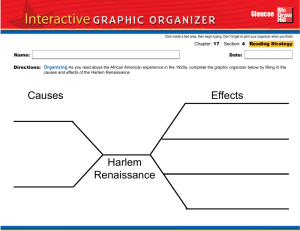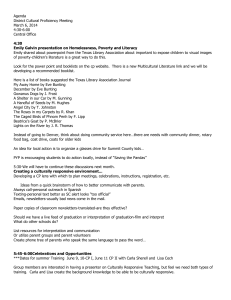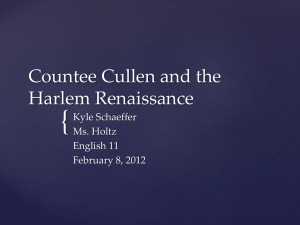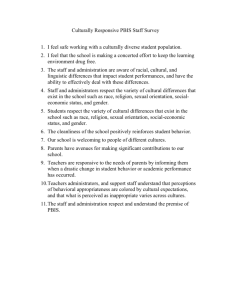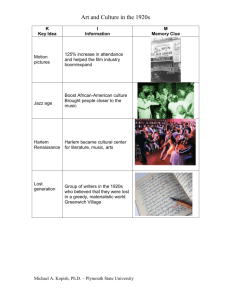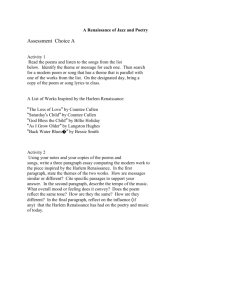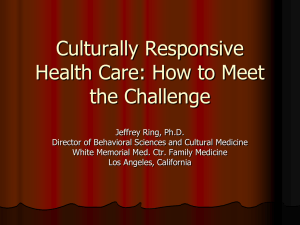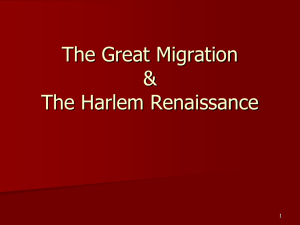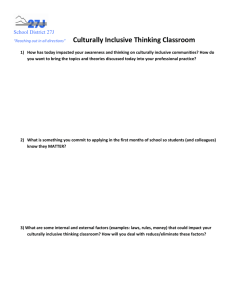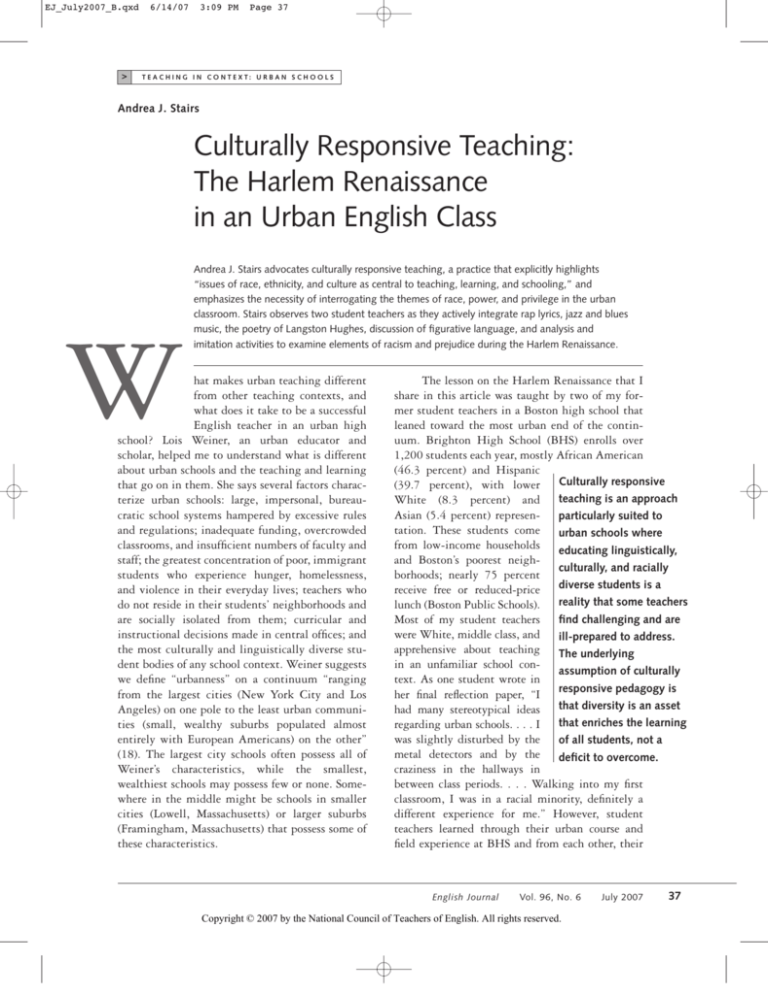
EJ_July2007_B.qxd
>
6/14/07
3:09 PM
Page 37
T E A C H I N G I N C O N T E X T: U R B A N S C H O O L S
Andrea J. Stairs
Culturally Responsive Teaching:
The Harlem Renaissance
in an Urban English Class
W
Andrea J. Stairs advocates culturally responsive teaching, a practice that explicitly highlights
“issues of race, ethnicity, and culture as central to teaching, learning, and schooling,” and
emphasizes the necessity of interrogating the themes of race, power, and privilege in the urban
classroom. Stairs observes two student teachers as they actively integrate rap lyrics, jazz and blues
music, the poetry of Langston Hughes, discussion of figurative language, and analysis and
imitation activities to examine elements of racism and prejudice during the Harlem Renaissance.
hat makes urban teaching different
from other teaching contexts, and
what does it take to be a successful
English teacher in an urban high
school? Lois Weiner, an urban educator and
scholar, helped me to understand what is different
about urban schools and the teaching and learning
that go on in them. She says several factors characterize urban schools: large, impersonal, bureaucratic school systems hampered by excessive rules
and regulations; inadequate funding, overcrowded
classrooms, and insufficient numbers of faculty and
staff; the greatest concentration of poor, immigrant
students who experience hunger, homelessness,
and violence in their everyday lives; teachers who
do not reside in their students’ neighborhoods and
are socially isolated from them; curricular and
instructional decisions made in central offices; and
the most culturally and linguistically diverse student bodies of any school context. Weiner suggests
we define “urbanness” on a continuum “ranging
from the largest cities (New York City and Los
Angeles) on one pole to the least urban communities (small, wealthy suburbs populated almost
entirely with European Americans) on the other”
(18). The largest city schools often possess all of
Weiner’s characteristics, while the smallest,
wealthiest schools may possess few or none. Somewhere in the middle might be schools in smaller
cities (Lowell, Massachusetts) or larger suburbs
(Framingham, Massachusetts) that possess some of
these characteristics.
The lesson on the Harlem Renaissance that I
share in this article was taught by two of my former student teachers in a Boston high school that
leaned toward the most urban end of the continuum. Brighton High School (BHS) enrolls over
1,200 students each year, mostly African American
(46.3 percent) and Hispanic
(39.7 percent), with lower Culturally responsive
White (8.3 percent) and teaching is an approach
Asian (5.4 percent) represen- particularly suited to
tation. These students come urban schools where
from low-income households educating linguistically,
and Boston’s poorest neighculturally, and racially
borhoods; nearly 75 percent
receive free or reduced-price diverse students is a
lunch (Boston Public Schools). reality that some teachers
Most of my student teachers find challenging and are
were White, middle class, and ill-prepared to address.
apprehensive about teaching The underlying
in an unfamiliar school conassumption of culturally
text. As one student wrote in
her final reflection paper, “I responsive pedagogy is
had many stereotypical ideas that diversity is an asset
regarding urban schools. . . . I that enriches the learning
was slightly disturbed by the of all students, not a
metal detectors and by the deficit to overcome.
craziness in the hallways in
between class periods. . . . Walking into my first
classroom, I was in a racial minority, definitely a
different experience for me.” However, student
teachers learned through their urban course and
field experience at BHS and from each other, their
English Journal
Vol. 96, No. 6
Copyright © 2007 by the National Council of Teachers of English. All rights reserved.
July 2007
37
EJ_July2007_B.qxd
6/14/07
3:09 PM
Page 38
Culturally Responsive Teaching: The Harlem Renaissance in an Urban English Class
professors, and their cooperating teachers that culturally responsive teaching would help them to be
successful in urban classrooms.
What Is Culturally Responsive Teaching?
Culturally responsive teaching is an approach particularly suited to urban schools where educating
linguistically, culturally, and racially diverse students is a reality that some teachers find challenging and are ill-prepared to address. The underlying
assumption of culturally responsive pedagogy is
that diversity is an asset that enriches the learning
of all students, not a deficit to overcome. Jacqueline
Jordan Irvine and Beverly Jeanne Armento explain
this approach: “The term culturally responsive pedagogy is used interchangeably with several terms
such as culturally responsible, culturally appropriate, culturally congruent, culturally compatible,
culturally relevant, and multicultural to describe a
variety of effective teaching approaches in culturally diverse classrooms. These terms all imply that
teachers should be responsive to their students by
incorporating elements of the students’ culture in
their teaching. . . . Responsive simply means reacting
appropriately in the instructional context” (4; italics in original). Some may wonder how this is different from what any good teacher does to engage
students and ensure that they see the relevance of
school in their daily lives. The difference is that
culturally responsive teachers make explicit the
issues of race, ethnicity, and culture as central to
teaching, learning, and schooling, a stance not
often evident in more homogeneous, suburban
teaching contexts. Interrogating and inquiring into
the relationships among race, power, and privilege
is typical in culturally responsive classrooms. A
“color-blind” approach to teaching diverse urban
students ignores critical aspects of students’ personal identities and senses of self and simply cannot
be perpetuated if we believe that success for all students is a priority.
Culturally Responsive Teaching
in Action: “Swaying To and Fro
on His Rickety Stool”
I use a line from Langston Hughes’s poem “The
Weary Blues” in the title of this section because it
represents the pupil engagement I observed during
38
July 2007
Cara and Laura’s culturally responsive lesson on the
Harlem Renaissance taught to a diverse, ninthgrade English class of twenty-eight students. Cara
and Laura were White undergraduate women who
were partnered to complete an urban methods
course and field experience under my supervision at
BHS and were participants in my larger study of
effective teacher preparation for urban teaching
(Stairs, “Preservice,” “Urban”). Their cooperating
teacher at BHS, Karen Coyle, was a National Board
Certified English teacher with six years’ experience.
She incorporated many workshop elements in her
student-centered classroom and she co-taught the
site-based methods course with me, providing student teachers with an example of a successful,
young, White teacher in a diverse urban school.
Cara and Laura decided to teach a lesson titled
Metaphor and Poetry in the Harlem Renaissance
after consulting with Coyle. They said the structure
of their lesson imitated the format Coyle modeled
for them: begin with a Do Now, conduct a minilesson, provide time for guided practice, share out with
the class, and wrap up at the end. As Laura reflected
after they had observed Coyle and taught in the long
block period, “You can’t just do direct instruction
the whole time. The kids won’t respond to it.”
Cara and Laura’s lesson began with a start-up
activity written on the board: “Please define
metaphor, simile, and renaissance, and then write
about what comes to mind when you think about
the word Harlem.” After allowing the students just
under ten minutes to write, Cara and Laura focused
on figurative language. They called on students by
name to read their definitions of simile and
metaphor and clarified the definitions. They placed
examples and nonexamples of metaphors and similes on the overhead and called on students to read a
line and identify it as a simile, a metaphor, or neither. The dozen lines they projected were all from
popular rap songs familiar to many students. One
line read, “I’m like a young Marvin in his hay, I’m a
hustler homie (Jay-Z)”; another read, “I love you
like a fat kid loves cake (50 Cent).” Laura said, “The
sentences I chose were . . . quotes from rap songs. So
we thought that would just kind of get the kids
engaged in the lesson right away. Like a fun kind of
start, just a quick review of simile and metaphor, so
I thought that was pretty engaging. They seemed
to enjoy it.” I observed that students were smiling
EJ_July2007_B.qxd
6/14/07
3:09 PM
Page 39
Andrea J. Stairs
and quietly giggling as each rap-song line was read;
they were clearly engaged with the lesson opener.
Additionally, the students’ playful reactions to the
use of rap-song lyrics showed appreciation for the
preservice teachers’ attention to youth culture in
general and African American culture in particular.
This is not to suggest that all Black students or all
young people like rap music, but it is a familiar art
form to most students, and the lines selected from
songs were frankly pretty entertaining. The choice
of lesson opener also reminds us that we need to
thoughtfully engage students with the lesson topic
from the beginning and throughout the lesson,
especially since many urban students experience
basic skills instruction, sometimes from scripted
curriculum, and therefore miss opportunities such
as these.
For the minilesson, students shared their
written responses to the word Harlem. Laura called
on students as Cara wrote their responses on the
board, such as New York, basketball, subway, African
Americans, Walter Dean Myers, shopping, theater, and
gangs. They asked students who had visited Harlem
to share their impressions and then moved ahead
with a handout titled, “The Harlem Renaissance,”
which included a map of 1920s “Harlem Hot
Spots” and a paragraph describing the rebirth of
Harlem during that time period. In our interview,
Cara told me how important it was to be sure students understood that the purchase of New York
real estate was dominated by White buyers until
the Harlem Renaissance, when a developer came to
Harlem and provided Blacks opportunities to
become homeowners, beginning the rebirth of
African American culture in the United States. She
said, “We weren’t sure how much exposure they
might have to classical jazz music,” which is why
they proceeded with the next steps in their lesson.
Cara called on a student to read the paragraph and
then explained more about what went on at the hot
spots on the map, such as the Cotton Club’s jazz
musicians and dancers. Cara played a jazz song by
Duke Ellington and asked students to write words
they heard about Harlem; a few wrote, but most
swayed in their seats and snapped their fingers,
reminding me of the line from Hughes’s poem,
“Swaying to and fro on his rickety stool.” Cara told
them that Langston Hughes was known for the
beat and rhythm in his poetry, just like in the
music. Later she told me, “I thought these kids
would really like the music in the class. . . . They
don’t usually listen to music in English, so I
thought it was kind of interesting and got them
excited about the lesson, to get them motivated.”
Laura then provided a picture of the poet and
a paragraph-long biography of Langston Hughes,
which one student read aloud. Laura’s next handout
included Hughes’s poem “The Weary Blues” and a
few clip-art pictures of musicians. She played blues
music in the background as she read “The Weary
Blues.” Again, students swayed and snapped with
the music. When she finished reading, she let the
music continue playing and conducted a discussion
about the tone of the poem and music (tone was a
literary term students had been working on most
recently) and how it was different from the jazz
music. Students said the poem was depressing and
about dying, and she encouraged students to go
back to the text and provide specific examples supporting their claims. When Laura shared that she
was a musician and that part of being an effective
musician is to create tone, just as in Hughes’s
poetry, a girl asked what instrument she played.
Laura said she played the oboe, and students giggled. During our interview Laura mentioned that
BHS pupils were interested in what was going on
in their student teachers’ lives, which is why she
told them she played the oboe, “and that got a few
chuckles. . . . So I think telling them about our
lives, too, they are interested in what we are doing.
And that Ms. Coyle even mentioned afterwards that
she thinks that personalizing the lesson instead of
just telling them, ‘Here is the Harlem Renaissance.
This is what it was like. Here is Langston Hughes.’
Telling them about what it means to us transfers a
lot of meaning to them, too.”
Cara and Laura also worked on “Dream
Deferred” with the whole class. Cara asked students
if they remembered reading A Raisin in the Sun earlier that semester and who remembered what
deferred meant; one boy said, “To put off.” They
then asked for fourteen volunteers, as the poem had
fourteen numbered stanzas of varying lengths,
which represented fourteen different voices of
Harlem residents during the Harlem Renaissance;
however, they did not tell the students this before
reading the poem. After reading and hearing fourteen different students read the fourteen stanzas,
English Journal
39
EJ_July2007_B.qxd
6/14/07
3:09 PM
Page 40
Culturally Responsive Teaching: The Harlem Renaissance in an Urban English Class
Cara asked students why they had fourteen people
read. Students replied, “Because each person in the
poem wants something different,” “It sounds different,” and “Each person reads differently.” Laura
probed further by asking why Hughes wrote the
poem this way. One student said that each stanza
represented a different dream. Another said,
“They’re all put on hold, just like the title.” Cara
called out different numbers of the different readers
and asked them what they wanted—a stove, two
suits, a radio. Cara explained that Hughes wrote
about dreams and struggles of real people in
Harlem, as was evident in the poem.
Laura then provided two handouts, one with
three of Hughes’s poems and one with three questions about each poem related to metaphor. Laura
read “Mother to Son” from the handout and led
students through the concept of extended
metaphor. She instructed students to turn to a
partner and work together on the handout’s
questions about this poem. After sharing
answers, Laura and Cara instructed students to
form small groups and finish
The use of rap lyrics to
reading and responding to
discuss figurative
the other two poems on the
language, the minilesson
handout (“Dreams” and “I,
on the Harlem
Too, Sing America”). Students
selected their groups quickly
Renaissance and
and worked diligently on the
Hughes’s poetry, playing
assignment as Cara and Laura
jazz and blues music, and
moved from group to group
the in-class and
providing support. After twentyhomework assignments
five minutes, Cara and Laura
of poetry analysis and
brought the class together to
imitation serve as
share what students had
learned about metaphors in
examples of culturally
Hughes’s poetry. They focused
responsive pedagogy.
specifically on the discrimination that Hughes expressed in “I, Too, Sing America” and how discrimination today compared to
that of the 1920s. Cara and Laura explained the
homework handout, which had Hughes’s poem
“Theme for English B” and the following directions: “After reading ‘Theme for English B,’ write
your own ‘Theme for English C’ (C block) relating
your feelings about school. Things to include:
Hughes’s jazz style writing, 1 simile, 1 metaphor,
at least 10 lines.” After homework was assigned,
the lesson concluded.
40
July 2007
Analysis of Cara and Laura’s Lesson
as Culturally Responsive Teaching
Cara and Laura’s lesson is a remarkable example of
culturally responsive teaching. Cara and Laura
knew their students (particularly in C block) and
knew the types of activities that would engage
them. They planned a lesson with both variety and
consistency, moving smoothly from one moment to
the next. The use of rap lyrics to discuss figurative
language, the minilesson on the Harlem Renaissance and Hughes’s poetry, playing jazz and blues
music, and the in-class and homework assignments
of poetry analysis and imitation serve as examples of
culturally responsive pedagogy. Ana María Villegas
and Tamara Lucas suggest “[c]ulturally responsive
teachers not only know their students well, they use
what they know about their students to give them
access to learning” (27). To teach figurative language, Cara and Laura used what they knew about
their students to make the lesson interesting and
personally relevant. They also applied theoretical
constructs underlying improved academic performance by African Americans: “[m]otion and movement, music, frequent variability in tasks and
formats, novelty, and dramatic elements in teaching” (Gay 112).
An aspect of culturally responsive pedagogy is
knowing students as individuals and as members of
cultural groups (Irvine and Armento; Villegas and
Lucas), and Cara and Laura believed that the success
of their lesson hinged on their relationship with
their students. These preservice teachers and their
pupils in C block had developed mutual respect
and enthusiasm for each other and their shared
learning experiences. In a short span of time—
a total of ten Thursdays over the course of a
semester—Cara and Laura learned the tendencies
for each class of students, as well as students’ individual strengths and weaknesses; they used this
information to adapt instruction. Not only did they
understand how important it was to modify
instruction based on pupils’ needs, but they also
understood the complexity of urban teaching.
Laura’s suggestion that “You’ve got to pick and
choose your battles” is in line with advice from
urban educator and scholar Lois Weiner, whose
work was at the center of our urban course and field
experience. Weiner suggests, “[G]ood teaching
EJ_July2007_B.qxd
6/14/07
3:09 PM
Page 41
Andrea J. Stairs
starts with knowledge of your students. The more
you know about your students, the more effective
you will be because you’ll be able to find that lesson
or project that will excite them, and you” (29). It is
also in line with the practices modeled by Cara and
Laura’s cooperating teacher, Ms. Coyle, reinforcing
the influence of an effective cooperating teacher.
When I asked Cara and Laura in our postobservation conference to share more about what
they thought their students learned from their
Harlem Renaissance lesson, and how they knew
they learned, they mentioned formal and informal
ways they evaluated student learning. They suggested that the students learned about simile and
metaphor, as evidenced in their group work and the
poems they wrote for homework. They also thought
they learned other important lessons:
I think they learned about the Harlem Renaissance and what was going on through the poetry,
too. In the “I, Too, Sing America” they saw the
prejudice and racism, too, and that was shown
through the literature and they wrote about that
in their responses to the questions. So they definitely learned about the Harlem Renaissance and
how the music and the culture, the explosion of
literature, how that influenced like, African
Americans began writing, writing of their experience, so I think they saw that, too. (Laura)
I think they also saw, especially with playing the
music, they saw, they felt the jazz rhythm and then
they were able to see that in the actual poems and
connect it, which I think was important for them
to see how poetry could be influenced or writing
could be influenced by something else. (Cara)
Perhaps more important than learning about figurative language, students recognized elements of
racism and prejudice in Hughes’s work. Gloria
Ladson-Billings states, “Culturally relevant teaching is about questioning (and preparing students to
question) the structural inequality, the racism, and
the injustice that exist in society” (128). Cara and
Laura provided these opportunities with their lesson, and students responded to these topics in their
writing, engaging with difficult ideas that most
understood firsthand from personal experience
many decades after Hughes wrote his poetry, as in
this excerpt from one student’s poem written for
Cara and Laura’s homework assignment:
If you take a walk through my soul
All you’ll hear and see is anger
A screaming child wrapped up in a sheet
Tangled, fighting to get out.
On second thought,
Why not stay in my cocoon wrapped?
Outside, there’s more hate and violence going on.
Though this student compared going to school
with a “screaming child
Perhaps more important
wrapped up in a sheet,” she
preferred this cocoon to the than learning about
world she faced daily outside figurative language,
the school’s doors, reminding students recognized
us of the realities many urban elements of racism and
students experience in their prejudice in Hughes’s
neighborhoods and how necwork.
essary it is for teachers to prepare students to critically examine society, equity,
and opportunity.
Making the Case for Culturally
Responsive English Teaching
As English teachers, we are always making choices
about what to teach and how to teach it, balancing
the classics with contemporary texts, juggling
reader response with formalist theory. Though all
English teachers share the experience of negotiating
contradictions and controversies in determining curriculum, Though all English
instruction, and assessment, we teachers share the
must recognize that teaching experience of negotiating
English in urban schools is dif- contradictions and
ferent than teaching in other controversies in
contexts. Today, urban teaching determining curriculum,
means not only a diverse stuinstruction, and
dent population, bureaucratic
school system, and lack of assessment, we must
resources but also a preva- recognize that teaching
lence of “test-prep pedagogy” English in urban schools
(McNeil). With the demands is different than teaching
of meeting adequate yearly in other contexts.
progress per No Child Left
Behind and keeping their schools off the local newspapers’ failing-schools lists, some English teachers feel
compelled (or are mandated by their school districts)
to revert “back to the basics” with underperforming
urban high school students. However, they know in
reality that providing rich literacy opportunities
English Journal
41
EJ_July2007_B.qxd
6/14/07
3:09 PM
Page 42
Culturally Responsive Teaching: The Harlem Renaissance in an Urban English Class
will improve test scores more than drilling students
with worksheets on grammar and literary terms.
Cara and Laura’s lesson demonstrated the
potential of culturally responsive pedagogy for
motivating and engaging urban high school students. The students’ positive response to the
numerous learning opportunities in an eightyminute English block should be evidence enough
for the value of culturally responsive pedagogy. One
student wrote on the lesson evaluation survey, “I
like the fact that we got to listen to music while
reading poetry. Though it’s not my kind of music,
it was cool.” Another said, “I liked it because it was
organized. They looked like they were teaching
years. It was awesome.” However, I further make
the case that urban students will develop their language arts skills and be better prepared to succeed
in a multicultural and global knowledge society
(Hargreaves) by drawing from the rich variety of
experiences and intelligences students bring with
them to our English classes. Culturally responsive
teaching helps us to be successful urban English
teachers.
I conclude with the words of Ladson-Billings,
who also makes the case for culturally relevant
teachers:
They see their teaching as an art rather than as a
technical skill. They believe that all of their students can succeed rather than that failure is
inevitable for some. They see themselves as a part
of the community and they see teaching as giving
back to the community. They help students make
connections between their local, national, racial,
cultural, and global identities. . . . They encourage
a community of learners; they encourage their students to learn collaboratively. . . . They view the
content of the curriculum critically and are pas-
sionate about it. Rather than expecting students
to demonstrate prior knowledge and skills they
help students develop that knowledge by building
bridges and scaffolding for learning. (25)
When we approach our urban English classrooms
in this manner, the possibilities for meaningful literacy learning, as well as social justice and equity,
are endless.
Works Cited
Boston Public Schools. “Focus on Children: Schools.”
Brighton High School. 2004. 17 Sept. 2005
<http://www.boston.k12.ma.us/schools/schname.asp
#B>.
Gay, Geneva. “Preparing for Culturally Responsive Teaching.” Journal of Teacher Education 53.2 (2002):
106–16.
Hargreaves, Andy. Teaching in the Knowledge Society: Education in the Age of Insecurity. New York: Teachers College, 2003.
Irvine, Jacqueline Jordan, and Beverly Jeanne Armento.
Culturally Responsive Teaching: Lesson Planning for Elementary and Middle Grades. Boston: McGraw, 2001.
Ladson-Billings, Gloria. The Dreamkeepers: Successful Teachers
of African American Children. San Francisco: JosseyBass, 1994.
McNeil, Linda M. Contradictions of School Reform: Educational
Costs of Standardized Testing. Critical Thought Series.
New York: Routledge, 2000.
Stairs, Andrea J. “Preservice Teacher Learning in an Urban
School-University Partnership.” Unpublished doctoral dissertation. Boston College. 2006.
———. “Urban Immersion: A Prototypical Early Clinical
Immersion Experience.” Recruiting, Preparing, and
Retaining Teachers for Urban Schools. Ed. Kenneth R.
Howey, Linda M. Post, and Nancy L. Zimpher.
Washington DC: American Association of Colleges
for Teacher Education, 2006. 49–65.
Villegas, Ana María, and Tamara Lucas. “Preparing Culturally Responsive Teachers: Rethinking the Curriculum.” Journal of Teacher Education 53.1 (2002):
20–32.
Weiner, Lois. Urban Teaching: The Essentials. Rev. ed. New
York: Teachers College, 2006.
Andrea J. Stairs is assistant professor of English education at the University of Tennessee. She is a former middle school and
high school English teacher and literacy coach. email: astairs@utk.edu.
READWRITETHINK CONNECTION
Lisa Storm Fink, RWT
The Harlem Renaissance was a vibrant time that was characterized by innovations in art, literature, music,
poetry, and dance. “A Harlem Renaissance Retrospective: Connecting Art, Music, Dance, and Poetry” invites
students to conduct Internet research, work with interactive online tools, and create a museum exhibit that
highlights the work of selected artists, musicians, and poets of the Harlem Renaissance. The culturally relevant
teaching in this lesson emphasizes critical thinking, creativity, and interdisciplinary connections.
http://www.readwritethink.org/lessons/lesson_view.asp?id=252
42
July 2007

